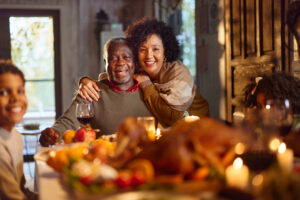Falls are the leading cause of injuries among older adults in the U.S., according to the National Council on Aging. And falls can happen to anyone. What’s more, as the weather gets colder and the days get shorter, we tend to become more sedentary, which increases the risk of falling. Autumn is the ideal time to work on building balance with some low-impact exercises that are easy to do at home.
“Maintaining one’s balance requires the brain to integrate information from the eyes, inner ear, joints and body systems,” says Grace Dayanghirang, DPT, a CentraState physical therapist. “When these systems are faulty or reaction time to sensory changes is slow – as can happen with seniors – the body may struggle to balance and then fall.”
To help with this, Dayanghirang suggests performing at-home exercises, such as the following circuit for about 10 minutes, one to two times per day, three to five days each week. These exercises focus on building balance, strengthening muscles, improving flexibility and enhancing coordination:
- While seated, stretch your hamstrings by extending your legs. Hold each leg for 20-30 seconds; repeat three times per leg.
- While seated, stretch your legs out, flex your ankles, wiggle your toes and spell the alphabet with each flex of your foot.
- Do 10 sit-to-stand exercises from a chair. Looking to make it more challenging? Add 20 bicep curls while holding filled water bottles as weights held at shoulder height.
- Stand holding onto a chair or countertop for support. Go up and down on your tiptoes 10 times.
- While standing, holding onto a countertop or chair, raise your toes, and hold for three to five seconds. Repeat 10-20 times.
- Walk heel to toe around your living room or down hallways 10 times.
“It’s also important to get your hearing and vision checked as you get older to help prevent falls,” adds Dayanghirang. “Some other steps you can take are ensuring you have well-fitting footwear with a sturdy sole for traction, and carrying a small backpack, cross-body handbag or belt bag to keep your hands free to balance while you’re out.”
How to Fall Safely
It’s not always possible to prevent a fall, but there are ways to minimize potential injuries. Consider this advice from Dayanghirang:
- Stay relaxed and loose; bend your elbows and knees.
- Protect your head by tucking your chin into your chest.
- Aim for a softer landing if possible (carpet, grass, dirt or a bush).
- Spread the impact by curling into a ball and rolling.
- Try to land on fleshy parts of the body (thighs and buttocks) rather than on your wrists or elbows.
- Once you land, do a quick self-assessment. If you are dizzy, in pain or have trouble moving your arms or legs, stay there and try to alert someone for help.
- If you feel safe, turn onto your belly, and get up on your hands and knees. Crawl to the closest sturdy surface that you can pull up on with your hands. Get into a kneeling position. Bring one leg up at a time as you move to a standing position.
Seek medical care if you feel dizzy, experience pain, have sustained a cut or develop a suspicious-looking bruise. If you’re concerned about balance issues, talk to your physician or a physical therapist.
Physical Therapy & Rehabilitation at CentraState
Learn more about Physical Therapy and Rehabilitation services at CentraState.





